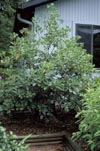Home >
Rhodoleia championii, Rhodolea
This is a beautiful plant in flower, but considered difficult to grow by nursery operators. The one in my garden flowers each year in the partial shade and is absolutely splendid. It is unfortunate that this plant is not more available to the trade. The plant is dense in partial shade or full sun with leaves remaining on the plant for four years. If exposed to drought conditions, older foliage drops from the plant but flower buds remain intact and the plant flowers nicely. Flowers are occasionally damaged by temperatures below about 26 degrees if the cold weather comes when flower buds are expanding or the flowers are open.
Think of using this plant as you would tree-form Japanese ligustrum. Provide occasional irrigation in dry weather to keep all foliage on the plant. Nutrient deficiencies sometimes experienced in container production disappear once planted into the landscape. Regular micronutrient applications might be needed in alkaline soils.
Prune
the tree so trunks and branches will not rub each other. Remove some secondary
branches on main branches with included bark. This reduces the likelihood
of the main branch splitting from the tree later when it has grown to
become an important part of the landscape. Locate the tree properly, taking
into account the ultimate size, since the tree looks best if it is not
pruned to control size. The tree can enhance any landscape with its delightful
spring flush of foliage. It can be the centerpiece of your landscape if
properly located.






